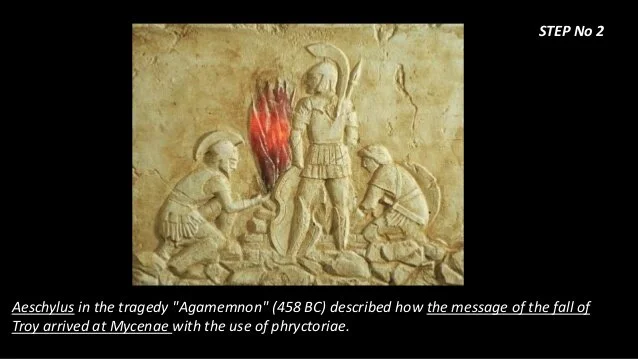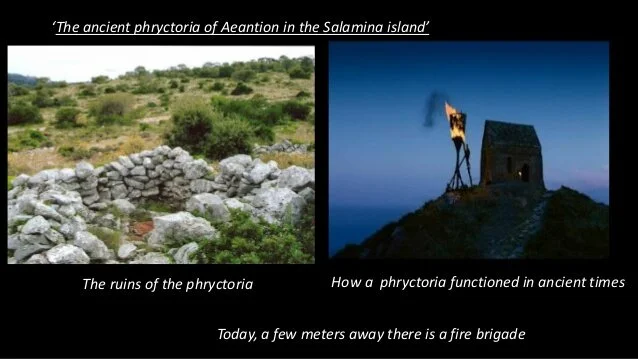The Ancient Greeks didn't have the technology at the time to send messages so they developed different ways to communicate to people at long distances.
Aegeas - Theseus (Prehistoric times - Mythology)
A classic example of an ingenious way of communication by the ancient Greeks over long distances is found in the story of Theseus, son of the king of Athens Aegea, from prehistoric mythological times, who undertook the difficult task of ending the subjugation of Athens to the Cretan king Minos.
Every year the Athenians had to send seven boys and seven girls to be the food of the monstrous Minotaur.
Taking the place of one of the boys, Theseus managed to kill the Minotaur in the labyrinth.
However, on his return, he forgot to put a white sail on his ship (communication code), as agreed in case of victory, with the result that Aegeas, seeing the black sail, fell from the rock of Sounio out of despair, thus giving the sea the name "Aegean".
Fryktoria (1100 - 500 BC)
The Fryktories were specially constructed towers on mountain tops where the first transmitters lit fires to transmit visual signals over long distances.
A classic example is the transmission of news of the fall of Troy from Agamemnon to Queen Clytemnestra (at Mycenae), in a single day.
According to the OTE Telecommunications Museum of Greece, there were at least six frying pans in operation in the past, most of which ran over communication links between the islands of the Aegean Sea. The method of frying pans was used until the Byzantine period for the implementation of the communication link between Rome and Constantinople.
Its abolition also marked the end of the Byzantine Empire. The importance of the locations chosen for the frying pans can still be seen today, as modern transponders operate in the same locations.
Lacedaemonian Scytale (7th century BC)
The Lacedaemonian or Krypteia Scytale is essentially the first encryption code using the method of permutation.
The system was based on the use of two identical scytales, into which a thin strip of treated leather was wrapped in such a way that there were no gaps between the wrappings.
When the sheet was unwound, the message could only be read if it was rewound in the same way.
One Scytale was held by the Spartans located in Sparta and the other by the fighting general who was in the campaign.
The Phaistos Disk (1700 BC)
The famous Phaistos disk in Crete is the first typographic page known to mankind and also the first recorded "coded" message. From 1908 until its discovery, it remains unexplained despite the efforts of famous scientists.
The fact that the repeating characters are identical proves that wooden and metal stamps were used to "print" the symbols on soft clay before it was fired.
The chronological birth of this makes it admirable.
Cryptography: Code Protractor (4th century B.C.)
The method referred to as the "protractor code" was an extremely simple system for encrypting short messages. In a disk with a diameter of 8-10 cm, 24 holes were drilled around the circumference (as many as the letters of the alphabet) and one more in the middle. In addition, on an imaginary diameter with the tip of one of the peripheral holes was an intermediate piece, about two centimeters from the center. This hole also determined the position of the first letter of the alphabet "A", while the rest are considered to correspond to the remaining 23.
Variation of the system could be the definition of another letter as a starting point for reading. This was done after secret prearrangement between the communicating parties. The message was recorded by means of a thin string knotted in the middle, and from there passed successively through the holes corresponding to the letters of the message.
If a letter was repeated, the string was passed twice through the same hole and wrapped around the circumference of the disk. The message was read from end to beginning, with the "unwinding" of the string.
Waxed diptychs (4th century B.C.)
Diptychs made of wax were probably one of the most important methods of conveying messages.
The message was carved onto a candle or tar, which was painted onto the surface of wooden panels for this purpose and were joined together by some kind of joint.
In order to capture the words, since the information was secret, a pre-arranged encoding method was used and the writing was placed upside down, requiring a mirror to read correctly.
A typical example of a modification of the system is the way in which the Spartan Dimaratus, even in exile in Persia (4th century BC), sent information to Sparta that King Xerxes was planning a campaign against them. So he carved the message on the wooden surface of the shields and covered them with wax. Then he sent the seemingly blank plaques to Sparta, where the wife of King Leonidas Gorgos, who guessed the trick, revealed the hidden information.
Hidden Letters (4th century B.C.)
The procedure of secret letters is described by Aeneas Tactecus as one of the most characteristic examples of cryptographic communication of the Ancient Greeks.
The procedure could be described as extremely simple. However, one must take into account, on the one hand, the chronological position of the method and, on the other hand, the level of knowledge of the Greeks' opponents at that time.
The encoded message contained all consonants, while the vowels were replaced by groups with a certain number of dots, depending on their alphabetical numbering.
Acoustic Telegraph - Alexander the Great (4th century BC)
The acoustic telegraph was first used in the campaigns of Alexander the Great, King of Macedon. The base of the circular sonic horn allowed its rotation in all directions without any problems.
The signal tone was clearly audible even at a distance of four kilometers.
Hydraulic Telegraph (4th century BC)
The hydraulic telegraph was an invention of Aeneas the Tactecus. It was used to transmit messages over long distances.
It was based on the use of two identical containers of water, in which floated a special object, on the stem of which were attached in fixed positions slips of paper with previously agreed messages.
It was sufficient to achieve the simultaneous opening and closing of the tap so that the object sank to the exact same point on both devices, and thus the same message label appeared on the rim of the container.
Coordination was achieved via light signals (communication code).
Pyrsia (150 BC)
Pyrsia was an invention of Kleoxenus and Democletus.
It is the forerunner of today's communication systems that use analog or digital coding.
It was based on the use of a system of two five large flares that could be distinguished at great distances with the aid of special stereoscopic binoculars.
The combination of flares fired by each of the five was translated into letters of the alphabet after appropriate reduction in special plates with two-dimensional tables.



















